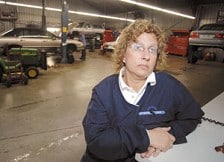Small businesses still struggling after ’08 Floods

.floatimg-left-hort { float:left; } .floatimg-left-caption-hort { float:left; margin-bottom:10px; width:300px; margin-right:10px; clear:left;} .floatimg-left-vert { float:left; margin-top:10px; margin-right:15px; width:200px;} .floatimg-left-caption-vert { float:left; margin-right:10px; margin-bottom:10px; font-size: 12px; width:200px;} .floatimg-right-hort { float:right; margin-top:10px; margin-left:10px; margin-bottom:10px; width: 300px;} .floatimg-right-caption-hort { float:left; margin-right:10px; margin-bottom:10px; width: 300px; font-size: 12px; } .floatimg-right-vert { float:right; margin-top:10px; margin-left:10px; margin-bottom:10px; width: 200px;} .floatimg-right-caption-vert { float:left; margin-right:10px; margin-bottom:10px; width: 200px; font-size: 12px; } .floatimgright-sidebar { float:right; margin-top:10px; margin-left:10px; margin-bottom:10px; width: 200px; border-top-style: double; border-top-color: black; border-bottom-style: double; border-bottom-color: black;} .floatimgright-sidebar p { line-height: 115%; text-indent: 10px; } .floatimgright-sidebar h4 { font-variant:small-caps; } .pullquote { float:right; margin-top:10px; margin-left:10px; margin-bottom:10px; width: 150px; background: url(http://www.dmbusinessdaily.com/DAILY/editorial/extras/closequote.gif) no-repeat bottom right !important ; line-height: 150%; font-size: 125%; border-top: 1px solid; border-bottom: 1px solid;} .floatvidleft { float:left; margin-bottom:10px; width:325px; margin-right:10px; clear:left;} .floatvidright { float:right; margin-bottom:10px; width:325px; margin-right:10px; clear:left;}
The water has receded and summer has been replaced by fall, yet the damage of the Floods of 2008 still lingers prominently in business owners’ minds, and has left one family-owned business bitter.
“Everything is so unbelievable, what you have to go through,” said Debbie Stephens, who runs Stephens Automotive Service with her husband, Jim, and son, Jeff. “It’s an experience that nobody needs to go through.”
Stephens Automotive, located on Northwest Beaver Drive, took on more than three and a half feet of water during this year’s floods, the same amount it did during the Floods of ’93.
“It’s really interesting,” she said with a sarcastic chuckle. “You learn to work with a flood after you have been flooded once.”
More than a hunch
Stephens said she had a good indication that she would need to evacuate the family-owned business this past June; after all, she had experienced similarly damaging floods 15 years earlier.
“When they put the yellow bladder up (on a nearby levee), you know then you only have 12 hours,” she said, “and where is that (water) going to go? Because if that (bladder) doesn’t hold, the water is going to go ‘whoosh,’ and then you have a problem.”
So in response to witnessing the bladder rise on the Iowa Department of Transportation levee on the west bank of the Des Moines River, Stephens set out to prepare for what she deemed inevitable a flood.
“We knew what was going to happen because it had rained too much,” she said. “That’s why we got everything in place.”
Immediately, Stephens got on the phone and ordered a Portable On Demand Storage unit, and anxiously drove around Des Moines in search of plastic totes to transport and store the shop’s tools and supplies.
“I think I bought every plastic container I could even think of in town,” she said. “I went to Lowe’s the Sunday before (the flood), and the guy looked at me like I was crazy. Then I went somewhere else and bought some more, and then I went somewhere else and bought some more. I bet I had 50 to 100 tubs.”
Stephens said she and her family were able to get most of their equipment moved out of the business’s two buildings before the flood water inundated the shops, and sought a temporary home up the road in a storage garage. In the process of moving computers, telephones and business documents, as well as enough tools to continue working on cars, Stephens said everything went surprisingly smoothly.
Bogged down in the aftermath
However, the smooth flood evacuation was short-lived, and once the waters receded, Stephens faced the daunting task of cleaning the family shop.
“I walked in and there were leeches, and there were snakes, and there were fish, and it’s just so much work,” she said.
Cleanup took less than a month and included installing new drywall, insulation, paint and framing, as well as tearing up carpet that had been laid barely a month before the flood hit. Currently, Stephens said, they are working on re-siding both buildings, because they “can’t withstand two floods.”
Unfortunately, Stephens thought she had flood insurance on both of the company’s buildings, but realized quickly that it only covered one – the one farthest from the river.
She explained that she didn’t realize, and wasn’t even told, that “you had to get an engineer and have a site (map) for the flood insurance for the government so you can get your second building covered.”
“But what can you do?” she asked herself rhetorically. “Nothing.”
Stephens explained that the cost of the damage that she and her family incurred was fairly substantial, but claimed they are pulling through, even in light of the poor economic climate and decreased car sales. Other businesses in the area, however, weren’t so lucky, and some even closed, Stephens said, as she pointed across the street to various leased spaces.
Davis Equipment Corp. President Joe Funkhouser said his company, which is located about a block south of Stephens Automotive, paid all of its flood expenses without the help of U.S. Small Business Administration (SBA) disaster loans, but declined to comment any further.
Dealing with the SBA
The Stephens family had applied for an SBA disaster loan to repair the damage that insurance didn’t cover, and was approved, but found out that they had to put up the business’s property as collateral, releasing them of ownership and putting it on a contract for buy-back.
“If you want it, if you want to give them your house, if you want to give them the land, the building, and all the equipment – the answer was: no we didn’t,” she said. “That is what they require. They wanted (to give us) a very small amount, for a very large amount for them. You pretty much have to give them your firstborn.”
Stephens and her husband refused the SBA disaster loan and decided to pay for the damage repairs out of their own pocket.
“Jim and I would be 87 years old when we paid off our SBA flood loan,” she said. “We would be 87 years old! We just looked at each other and laughed and said, ‘Yeah, right, I don’t think so.’ It’s not worth it.”
Rick Jenkins, communications manager for SBA’s disaster office in Sacramento, Calif., said the SBA requires collateral for Business Physical Disaster Loans that exceed $14,000 and for and all Economic Injury Disaster Loans loans that exceed $5,000. He said the SBA then sets up repayment options that can extend anywhere between five and 30 years, based on the borrowers’ ability to repay.
“The maximum loan is up to 30 years, but again it is based on your ability to repay the loa n,” he said. “We figure out what payment the business can afford and then arrive at the term.”
Jenkins said the SBA hasn’t had many people follow the Stephenses’ lead and refuse to pledge collateral, and said it is common for the SBA to use real estate as “the best form of collateral,” requiring a lien against the property for the amount of the loan.
The SBA has declined some small business owners’ request for disaster loans, claiming they have enough equity in their business to obtain a loan elsewhere.
“If someone had a large amount of equity, we would not make the loan,” Jenkins said. Also noting the SBA would not make a loan, “if a business has no intent of reopening the business; we wouldn’t allow it because there wouldn’t be an ability to repay (the loan).”
But Stephens said she and her husband are satisfied with their decision and wouldn’t hand over the ownership of their family-run business under any circumstances.
“We’re independent, but we’ll be all right,” she said. “It’s just like anybody else. You’re just in for the long haul, and we’re survivors, and we’re going to survive. We’re going to be OK. We’re still out there. We’re still doing it.”








